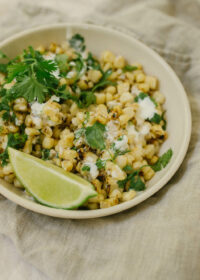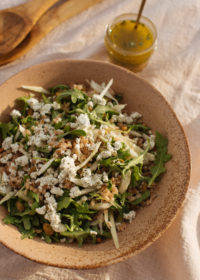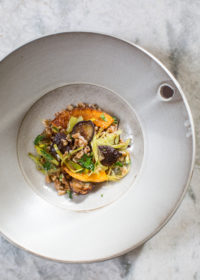Recipes: Radish & Hemp Seed Tabbouleh
 My first introduction to real tabbouleh was through my Lebanese friends in DC. My college roommates and closest friends were from Beirut, so we’d spend a few evenings throughout the year eating incredible home cooked Lebanese food with their families. I was straight up spoiled. They had a big influence on my culinary tastes, and you’ll find my kitchen always stocked with za’atar, sumac, and plenty of fresh mint and garlic.
My first introduction to real tabbouleh was through my Lebanese friends in DC. My college roommates and closest friends were from Beirut, so we’d spend a few evenings throughout the year eating incredible home cooked Lebanese food with their families. I was straight up spoiled. They had a big influence on my culinary tastes, and you’ll find my kitchen always stocked with za’atar, sumac, and plenty of fresh mint and garlic.
 I prefer Lebanese style tabbouleh compared to other varieties because it’s much greener and uses more herbs instead of grain. A traditional Lebanese tabbouleh calls for lots of parsley, cucumber, mint, tomato, white onion, olive oil, lemon juice, salt, a pinch of cinnamon and allspice, and just a small amount of bulgur. It feels much lighter and more alive than other varieties that use several cups of bulgur as the base.
I prefer Lebanese style tabbouleh compared to other varieties because it’s much greener and uses more herbs instead of grain. A traditional Lebanese tabbouleh calls for lots of parsley, cucumber, mint, tomato, white onion, olive oil, lemon juice, salt, a pinch of cinnamon and allspice, and just a small amount of bulgur. It feels much lighter and more alive than other varieties that use several cups of bulgur as the base.
 Since bulgur is wheat, I like to substitute my tabbouleh with hulled hemp seeds (or hemp hearts as you might have seen them called before) for a gluten-free version. Here’s a quick look at the nutritional profile of hemp:
Since bulgur is wheat, I like to substitute my tabbouleh with hulled hemp seeds (or hemp hearts as you might have seen them called before) for a gluten-free version. Here’s a quick look at the nutritional profile of hemp:
Nutritional Profile: Hemp Seeds
- A high protein seed containing all nine of the essential amino acids
- Nature’s highest botanical source of essential fatty acid, with more essential fatty acid than flax or any other nut or seed oil
- A perfect 3:1 ratio of Omega-6 Linoleic Acid and Omega-3 Linolenic Acid which is good for cardiovascular health and general strengthening of the immune system
- A rich source of phytonutrients, the disease-protective element of plants with benefits protecting your immunity, bloodstream, tissues, cells, skin, organs and mitochondria
- The richest known source of polyunsaturated essential fatty acids
- Hemp does not contain phytic acid, the chemical that inhibits nutrient absorption in most seeds and nuts unless soaked, making this seed easy to digest and readily obtain its nutrients
I also substituted the tomato with red radish, since tomatoes are nightshades and have been known to cause inflammation. And a note on the alliums – raw onions and I just don’t get along, so I left it out of this recipe and used garlic instead. However, if you love them feel free to add diced onions into this mix.
 RADISH & HEMP SEED TABBOULEH
RADISH & HEMP SEED TABBOULEH
1 cucumber, peeled & diced
4 radishes, diced
1 bunch parsley, finely chopped
1 cup mint leaves, finely chopped
2 cloves garlic, minced or grated
½ cup hulled hemp seeds
¼ cup olive oil
½ tsp Himalayan pink salt (or sea salt of your choice)
juice of 2 lemons
Peel and halve your cucumber lengthwise, then use a spoon to scrape seeds from your cucumber. Cut into lengthwise strips, then dice cucumber into small cubes. Place into a large bowl, then add in the remaining chopped ingredients. Toss with olive oil, lemon juice and salt. Grind in fresh pepper to taste, add more salt if desired.
Serves 4
Note: While cooling cucumbers and salads in general are good for balancing pitta, radishes can have a slightly heating effect. Omit the radishes from this recipe if needed.
 [wpmenucart]
[wpmenucart] Recipe: Grilled Corn & Cilantro Salad
Recipe: Grilled Corn & Cilantro Salad  Recipes: Summer Spelt Berry Salad with Tarragon Vinaigrette
Recipes: Summer Spelt Berry Salad with Tarragon Vinaigrette  Recipes: Autumn Farro Salad + A Thanksgiving Guide 2018
Recipes: Autumn Farro Salad + A Thanksgiving Guide 2018 
I just made this the other night. Forgot the garlic and it still turned out amazing! Thanks, you are an inspiration!
Thank you, Yvonne! I’m so glad you liked it. Keep in touch with your kitchen adventures, I always love to hear how things go!
[…] in a savory recipe. This recipe ties together a series of posts I did a while back. Remember that radish & hemp seed tabbouleh and the roasted red beet hummus? These two piled into this falafel wrap have become one of my […]
[…] roasted beets provide a healthy boost of digestible fiber, iron and Vitamin C. Pair it with some tabbouleh and falafel wraps, or always keep it around the house for a quick afternoon snack with some celery […]